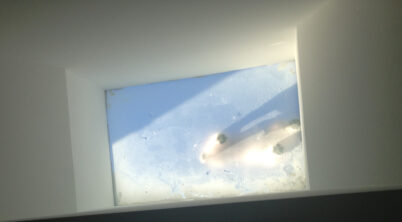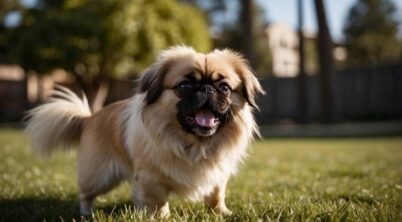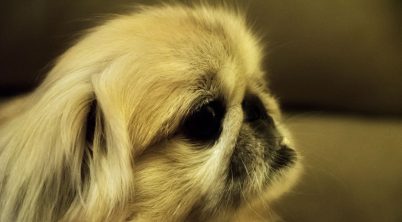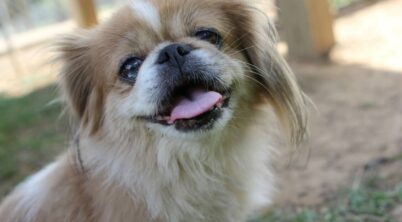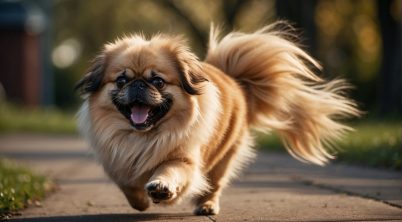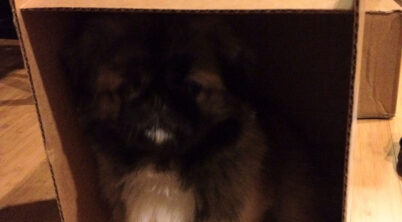The Pekingese, with its history rooted in the palaces of ancient China, is a breed that carries an air of regal dignity reminiscent of its past association with Chinese royalty. Affectionately known as the “lion dog” due to its resemblance to Chinese guardian lions, this toy breed was once the cherished companion of nobility, ensconced within the wealthy homes and afforded protections that matched their esteemed status. Their connection to Western awareness began when Queen Victoria was presented with a Pekingese after the British invasion of the Chinese Imperial Palace in 1860, which introduced this breed to a broader audience.
Physically, the Pekingese is a small dog, characterized by a stocky stature and a distinctive, flowing mane, which adds to its leonine appearance. Through selective breeding, the Pekingese has been designed to lead a more leisurely lifestyle, one that aligns with the confines of palace living. As a result, the breed is not commonly associated with hyperactivity but rather displays a balanced level of playfulness and calm. Nonetheless, they are capable of bursts of energy, particularly in their youth or when their environment stimulates such behavior.
Despite their serene origins, Pekingese do require engagement and can exhibit signs of restlessness if not provided with adequate mental and physical stimulation. It is important for owners to understand that while this breed may not demand extensive physical exercise, they thrive on interaction and activities that challenge their intelligent and somewhat independent nature. Owners need to approach training with consistency and patience, as the Pekingese can be strong-willed, a trait that harks back to their ancestral role as companions of ruling elites.
Table of Contents
Pekingese Hyperactive
When examining Pekingese behavior, one must understand that this breed is generally not hyperactive. Tranquility tends to be a hallmark of the Pekingese, showcasing a calm demeanor that pairs well with their compact size. These dogs may display playful behavior, but they do not typically require extensive exercise to maintain their composure.
However, like any dog, a Pekingese may exhibit signs of restlessness or hyperactivity if their needs for companionship, mental stimulation, and physical activity are not met. Providing daily walks, interactive toys for mental engagement, and consistent social interaction can help keep a Pekingese well-balanced and content.
In some cases where a Pekingese might display unusually high energy levels, there could be underlying causes such as:
- Lack of stimulation: They require moderate mental and physical activities.
- Dietary Issues: Inappropriate diets may lead to increased energy.
- Health Concerns: Various health issues might lead to a change in behavior.
If a Pekingese becomes hyperactive, they may benefit from:
- Routine: Consistency in walks and playtime to manage energy levels.
- Training: Positive reinforcement training to encourage calm behavior.
- Health Check: Veterinary examinations to rule out potential medical issues.
It is important for a Pekingese owner to be observant and responsive to their dog’s behavior while also being mindful of the breed’s standard temperament, which leans toward a more sedate lifestyle.
Breed Characteristics
The Pekingese is a toy breed, distinct for its compact and sturdy stature, with adult dogs usually standing about 6-9 inches tall. They possess a regal bearing complemented by a thick, double coat that comes in various colors, including gold, sable, black and tan, white, cream, and gray. The breed’s mane is often likened to that of a lion, giving it a particularly dignified look.
Temperament-wise, the Pekingese is a combination of affectionate and independent traits. They’re known for their playful yet willful nature, often showing a charming and confident disposition. The breed can be quite stubborn and may exhibit a degree of opinionated behavior when it comes to training. Despite their small size, they have an alert nature which makes them effective watchdogs.
When it comes to families with children, the Pekingese can be protective and affectionate; however, their interaction with young children should be supervised due to their small size and potential for injury. In terms of adaptability, the Pekingese is an excellent indoor dog that can thrive in apartment living, provided that its pace of life is respected.
Health-wise, Pekingese are brachycephalic, meaning they have short noses and flat faces, which can lead to breathing difficulties and other health problems such as joint diseases and progressive retinal atrophy. Their life expectancy generally ranges between 12 to 14 years.
Grooming is a high-maintenance affair for this breed. Regular brushing is necessary to manage their shedding, and occasional trimming may be needed to keep their coat neat. Due to their intelligence coupled with stubbornness, training can present challenges, emphasizing the need for consistent and patient training practices. Despite possible training difficulties, the Pekingese is adaptable to different environments and can be a delightful family dog when properly socialized and cared for.
Maintenance and Care
The Pekingese, a toy breed with a distinctive rolling gait, requires a well-considered care regimen that addresses its need for regular grooming, proper nutrition, sufficient exercise, and overall health management. It’s important to integrate training and socialization early to ensure a well-behaved and sociable pet.
Exercise Needs
Pekingese dogs do not require extensive physical activity, but they benefit from:
- Walking: Aim for two 20-minute walks per day to maintain their health.
- Playtime: Engage in activities like fetch, which can be indoor or outdoor, to stimulate their mind.
- The breed’s unique rolling gait should be considered when planning exercise, avoiding overly strenuous activities.
Health Management
Pekingese can be prone to certain health issues:
- Eye diseases: Due to their large, prominent eyes, they need regular check-ups.
- Joint diseases: The breed is susceptible to problems such as patellar luxation.
- Obesity: A strict diet and regular exercise help prevent weight gain, which can exacerbate health problems.
- Regular vet checkups are essential for early detection and management of health concerns.
Training and Socialization
Training a Pekingese requires patience and should focus on:
- Consistency and Obedience: Short, consistent training sessions work best to instill obedience.
- Early socialization with people and animals leads to a well-rounded temperament.
- Pekingese may show a stubborn streak, making positive reinforcement methods crucial.
Living with Other Pets
When introducing a Pekingese to other pets, keep in mind:
- Animal dynamics can vary; careful and gradual introductions help determine compatibility.
- A socialized Pekingese generally coexists well with other household animals.
- Dominance and territorial behaviors should be managed through training and consistent boundaries.
Health and Wellness
Pekingese dogs, recognized for their long, luxurious coats and distinct facial features, can have fulfilling lives with attentive care. They typically enjoy life spans of 12 to 14 years, which suggests good overall health when properly managed. This breed, however, is prone to certain health conditions that owners should be mindful of.
Diet and Nutrition
Pekingese can be selective with food, and it’s essential for them to have a balanced diet to prevent obesity. Moderation in feeding and a diet tailored to their specific needs help mitigate weight gain that could lead to additional health problems.
Exercise Needs
While Pekingese are not overly active, adequate exercise is crucial to maintain a healthy weight and improve cardiovascular health. Despite their stature, moderate daily walks and interactive play sessions will benefit their wellness.
Brachycephalic Concerns
Being a brachycephalic breed, Pekingese may suffer from breathing difficulties. Their short muzzles can cause respiratory issues, so it’s important to monitor them during exercise and avoid extreme temperatures.
Regular Veterinary Checkups
Regular vet appointments are vital to keeping Pekingese healthy. Early detection of eye diseases, joint diseases, and skin conditions can prevent them from developing into more serious issues.
Aging Challenges
Attention to senior dog care is important as they age. Older Pekingese may face aging challenges such as decreased mobility or chronic health issues. Adjustments in diet, exercise, and perhaps increased veterinary care can maintain their quality of life.
Preventive Health
Responsible practices like spaying and neutering contribute to preventing future health complications, including some cancers. Staying informed about the breed’s common health concerns facilitates proactive care for these dogs, allowing them to thrive.
Behavior and Training
In addressing the behavior and training aspects of Pekingese dogs, it is vital to understand their unique temperament. This breeds’ independent nature coupled with their intelligence can sometimes lead to stubbornness, making consistent training techniques essential for successful behavior modification.
Understanding Pekingese Behavior
The Pekingese possesses a confident and independent temperament. While they may be affectionate with their owners, they are known for their regal and sometimes aloof demeanor. Their intelligence means they understand commands but may choose when to obey them. This selective obedience is often mistaken for lack of intelligence, when in reality, Pekingese are discerning and willful pets.
Effective Training Techniques
For training a Pekingese, consistency is key. Because of their intelligent yet independent nature, they require a consistent and patient approach. Obedience training should start early, with the following focus areas:
- Positive Reinforcement: Reward good behavior with treats or praise to encourage repetition.
- Consistency: Maintain a consistent approach to commands and expectations.
- Behavior Modification: Identify undesirable behaviors early and guide them toward positive actions.
Addressing Bad Habits
Stubbornness and a tendency towards certain bad habits, such as barking or housebreaking issues, can be challenging with Pekingese. Corrective measures should be timely and involve:
- Command Training: Redirect unwanted behaviors with commands they know, such as “sit” or “quiet.”
- Structured Environment: Give them a well-structured living space where rules are clear and enforced.

